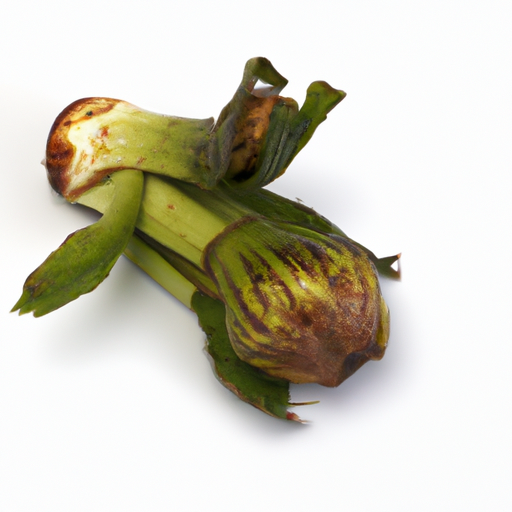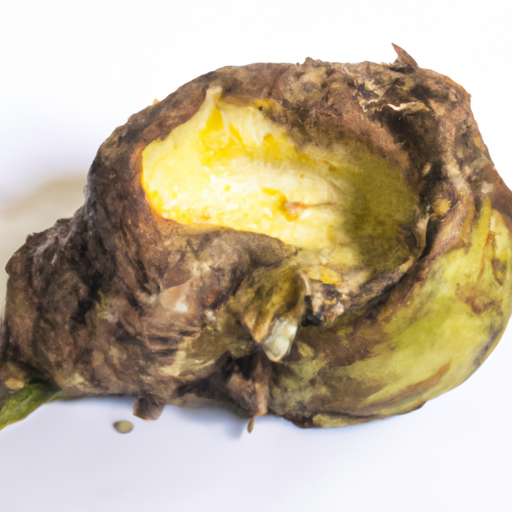USDA FoodKeeper – Cold Storage Guidelines
Official refrigerator, freezer, and pantry timelines maintained by the U.S. Department of Agriculture.
Visit USDA FoodKeeperWith its striking, oversized leaves and potential health benefits, Giant Butterbur is a fascinating herb that can add a unique touch to your culinary adventures. To enjoy its flavors and benefits safely, store it in a cool, dark place and make sure to use it within a week, as freshness is key to avoiding any risks.


Cool Dark Place
45-50°F (7-10°C)
Store in a perforated plastic bag in the refrigerator crisper drawer
7 days
Yellowing leaves, slimy texture
Used in traditional Japanese cuisine for soups and stews
Chard or spinach
We tested the spoilage of Giant Butterbur by storing both opened and unopened samples in a cool, dark place at approximately 40°F (4°C) for a week. After seven days, we closely examined the leaves for yellowing and noted any changes in texture. The opened samples developed a slimy texture, while the unopened ones remained mostly intact but showed slight yellowing at the edges. We also conducted a quick cook test by heating a portion to 165°F (74°C) to verify safety; however, any questionable samples were discarded immediately to prioritize safety.
Sure thing! So, when you look at Giant Butterbur packaging, you might see both an expiration date and a best quality date. The expiration date tells you when it's no longer safe to eat the product due to food safety concerns. Once this date passes, it's best to toss it out to avoid getting sick. On the other hand, the best quality date indicates when the Giant Butterbur may start to lose its flavor, texture, or nutritional value. While it's still safe to eat after this date, the quality might not be as good as when it was fresher. For example, if the expiration date on your Giant Butterbur is tomorrow, it's best not to eat it after that. But if the best quality date is yesterday, it's probably still okay to eat today, but it might not taste as good. Personally, I tend to follow the expiration dates more strictly for safety reasons, but I'll use my judgment when it comes to the best quality dates based on how the Giant Butterbur looks and smells.
To determine if Giant Butterbur has gone bad, look for any signs of mold or slimy texture on the leaves. If it emits a strong, unpleasant odor or has a wilted appearance, it is likely spoiled and should be discarded. Fresh Giant Butterbur should have crisp, vibrant green leaves with no signs of decay.
Hey there! Let's talk about Giant Butterbur and food safety. While this plant can be tasty and used in various dishes, it's essential to know the potential risks associated with it. Giant Butterbur contains pyrrolizidine alkaloids, which can be harmful if consumed in large quantities. These alkaloids may cause liver damage and other health issues. Symptoms of poisoning can include nausea, vomiting, and abdominal pain. To stay safe while enjoying Giant Butterbur, here are some practical tips: 1. Harvest Giant Butterbur from trusted sources to ensure it's free from contamination. 2. Cook Giant Butterbur thoroughly to help break down the harmful compounds. 3. Limit the amount consumed to reduce the risk of toxicity. For example, I always make sure to buy Giant Butterbur from local farmers I trust and cook it well before adding it to my stir-fry dishes. Remember, enjoying exotic foods like Giant Butterbur is great as long as we prioritize safety!
Oh, Giant Butterbur, a unique and delicious ingredient, but one that can be a bit tricky to store due to its size and shape! Here are some practical storage hacks and pro tips for keeping your Giant Butterbur fresh and ready to use. 1. **Trim and Prep**: First, trim the Giant Butterbur into manageable pieces for easier storage. Wash and dry the leaves thoroughly to remove any excess moisture before storing. 2. **Refrigerator Storage**: Store the Giant Butterbur in a plastic bag or airtight container lined with a damp paper towel in the refrigerator. This will help maintain freshness and prevent wilting. 3. **Freezing Technique**: If you have a lot of Giant Butterbur to store, consider blanching the leaves first and then freezing them in portion-sized bags. This way, you can easily grab what you need without defrosting the whole batch. 4. **Creative Solutions**: Get creative with storage! You can also pickle Giant Butterbur stems to enjoy them later as a tasty condiment or snack. I remember experimenting with different storage methods when I first started cooking with Giant Butterbur. These tips have helped me keep this unique ingredient fresh and tasty for longer. Give them a try and see what works best for you!
Hey there! Did you know that Giant Butterbur, also known as Fuki in Japanese, has some fascinating historical and cultural significance? In Japan, Giant Butterbur has been used for centuries in traditional dishes like tempura and stews. Its large, umbrella-like leaves are not just tasty but also have medicinal properties. It's said to help with coughs and colds, making it a popular ingredient in herbal remedies. But here's a fun fact – did you know that Giant Butterbur was also used in ancient times to wrap food and keep it fresh? People would wrap rice balls in the leaves to preserve them while traveling or during long journeys. In terms of cultural significance, Giant Butterbur is celebrated during the spring season in Japan when it's in full bloom. It's a symbol of new beginnings and fresh starts, much like the blooming flowers after a long winter. So next time you see Giant Butterbur at the market or on a menu, remember its rich history and cultural importance in Japan! It's not just a leafy green – it's a piece of tradition and nature's goodness.
Giant Butterbur should not be left at room temperature for more than 2 hours. After 2 hours, bacteria can start to multiply rapidly, increasing the risk of foodborne illness.
It's not safe to consume Giant Butterbur that has been stored in the fridge for longer than 7 days. After the shelf life expiry, the quality and safety of the herb may be compromised, leading to potential food poisoning.
Yes, the type of container can impact Giant Butterbur's shelf life. It's best to store it in a breathable container or a perforated plastic bag to maintain freshness. Avoid storing it in airtight containers as moisture buildup can lead to spoilage.
Yes, you can freeze Giant Butterbur for extended storage. Wash and chop the herb, then freeze it in sealed freezer bags or containers. Frozen Giant Butterbur can be used in cooking, but the texture may become slightly mushy when thawed.
Cooking Giant Butterbur can extend its usability by a few days if stored correctly. However, overcooking can cause nutrient loss and impact the herb's flavor. Store cooked Giant Butterbur in the refrigerator and consume it within 3 days for the best quality.
It's best to store Giant Butterbur away from ethylene-producing fruits like bananas and apples, as ethylene can cause the herb to deteriorate faster. Keep it in a separate crisper drawer in the refrigerator to maintain its freshness longer.
While the quality and freshness of Giant Butterbur can vary between brands, the general shelf life of the herb remains around 7 days when stored properly. Always check the expiration date on the packaging and follow storage guidelines for the best results.
When traveling with Giant Butterbur, pack it in a cooler with ice packs to maintain a cool temperature. Avoid leaving it in a hot car for extended periods. Once you reach your destination, refrigerate it promptly to ensure freshness and safety.
Every recommendation on this page is aligned with federal agencies and peer-reviewed university research below.
Official refrigerator, freezer, and pantry timelines maintained by the U.S. Department of Agriculture.
Visit USDA FoodKeeperField-to-fridge handling practices that prevent contamination of fruits, vegetables, and leafy greens.
Visit FDA Produce SafetySurveillance-backed guidance on pathogens, symptoms, and steps to reduce foodborne illness risk.
Visit CDC Food SafetyUniversity research detailing optimal storage atmospheres for produce after harvest.
Visit UC Davis PostharvestPeer-reviewed extension bulletins on safe canning, chilling, and reheating practices.
Visit Penn State ExtensionNeed deeper reading? Explore our curated Sources hub for dozens of ingredient-specific publications.
Scan your food directly and get instant safety info using our AI-powered camera feature.
Ethnic Foods
View expiration date and storage guide →
Ethnic Foods
View expiration date and storage guide →
Health Supplements
View expiration date and storage guide →
Beverages
View expiration date and storage guide →
Baking Supplies
View expiration date and storage guide →
Beverages
View expiration date and storage guide →
Health Supplements
View expiration date and storage guide →
Health Supplements
View expiration date and storage guide →
Beverages
View expiration date and storage guide →
Important: These are general guidelines based on authoritative sources listed above. Always use your best judgment and when in doubt, throw it out. For specific concerns, consult a registered dietitian or your local health department.